Atyrau is home to a plethora of birds. It provides a perfect habitat for birds, with its rivers, wetlands, and wetlands. The region is home to various species, including many migratory birds.
More than 150 species of birds have been observed in the region, including the White-Winged Woodpecker, the Great Egret, the Common Buzzard, the Eurasian Wren, and the Common Kestrel.
Atyrau also offers an excellent opportunity to watch and observe birds in their natural habitat. From the wetlands to the forests, bird watchers can find various bird species to observe.
10 Birds to Watch in Atyrau
Atyrau is a city in Kazakhstan that lies on the border of Europe and Asia. It is also home to a rich diversity of birds, thanks to its location near the Caspian Sea and the Ural River.
The region has a variety of habitats, such as wetlands, forests, steppes, and deserts, that attract many migratory and resident birds.
Here are 10 birds that you can watch in Atyrau and learn more about their ecology and conservation.
1. Ardea Alba
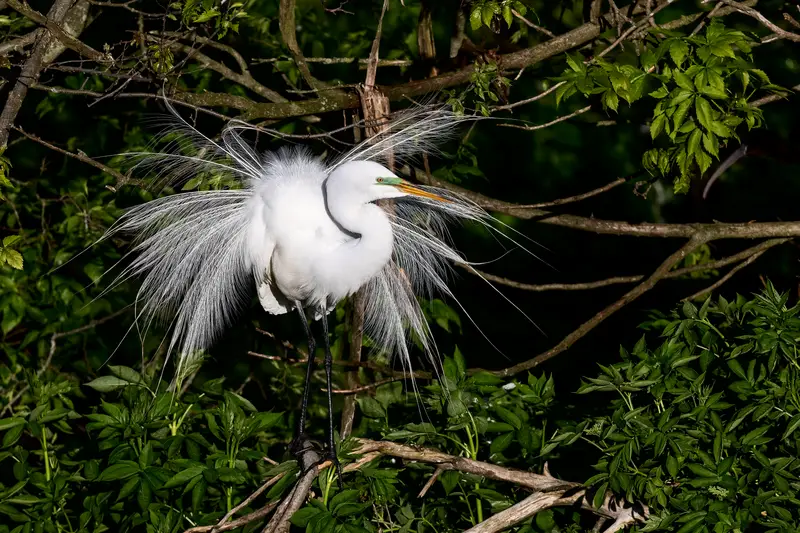
The great egret is a species of large egret that is widely distributed across the world. It is also known by other names such as common egret, large egret, great white egret, or great white heron.
It has four subspecies in Asia, Africa, the Americas, and southern Europe. In recent years, it has been observed that the great egret is also spreading to more northern areas of Europe, suggesting that it is becoming increasingly common in these areas.
The great egret is an impressive bird with a long neck, long legs, and a large body. It has a white plumage with a yellow beak and black legs. It is an opportunistic feeder and can be found near wetlands, marshes, and ponds.
It is often seen foraging for fish, amphibians, insects, and small mammals. The great egret is a protected species in many countries, and its population is increasing. This is due to conservation efforts that have been made to protect and preserve its habitat.
As a result, the great egret can now be found in areas where it was once rare or absent. The great egret is an iconic species celebrated in art and literature.
It is an essential species in the wetland ecosystem and is vital in keeping the water clean and healthy. It symbolizes beauty and grace, and its presence reminds us of conserving our natural environment.
| Kingdom | Animalia |
| Phylum | Chordata |
| Class | Aves |
| Order | Pelecaniformes |
| Family | Ardeidae |
| Genus | Ardea |
| Species | A. alba |
2. Great Cormorant
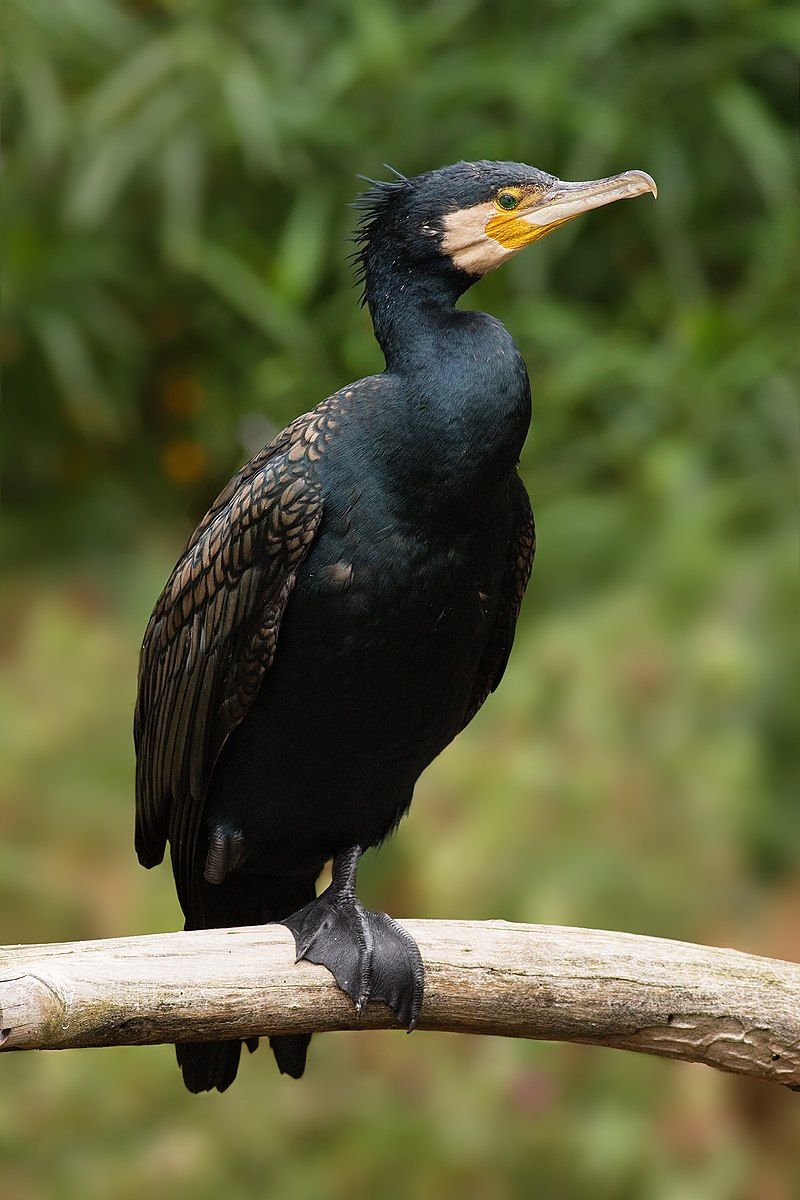
The great cormorant is a species of bird found in many parts of the world. It is known by various names, depending on the region. In New Zealand, the bird is known as the black shag or kawau.
In the Northern Hemisphere, it was formerly known as the great black cormorant; in Australia, it is called the black cormorant. In India, it is referred to as the large cormorant. The great cormorant is a member of the cormorant family of birds, making it a seabird.
It is widely distributed worldwide and can be found in many different climates. The bird is characterized by its black and white plumage, often contrasted with its yellow throat.
Its wings are relatively long, and its legs and feet are webbed, allowing it to traverse through water easily. The great cormorant is a versatile and opportunistic feeder, consuming a variety of prey, including fish, crustaceans, and mollusks.
While its diet is mainly composed of aquatic organisms, in some cases, it has been known to scavenge carrion and attack other birds.
It is known to form colonies at certain times of the year and can be found in various habitats, from coastal areas to estuaries, rivers, lakes, and marshes. Overall, the great cormorant is an impressive and adaptable bird in many parts of the world.
Various names in different regions know it, and its diet and habitat vary depending on location. Its ability to survive in different climates and its willingness to exploit various food sources make it an impressive and resilient species.
| Kingdom | Animalia |
| Phylum | Chordata |
| Class | Aves |
| Order | Suliformes |
| Family | Phalacrocoracidae |
| Genus | Phalacrocorax |
| Species | P. carbo |
3. Ruddy Shelduck
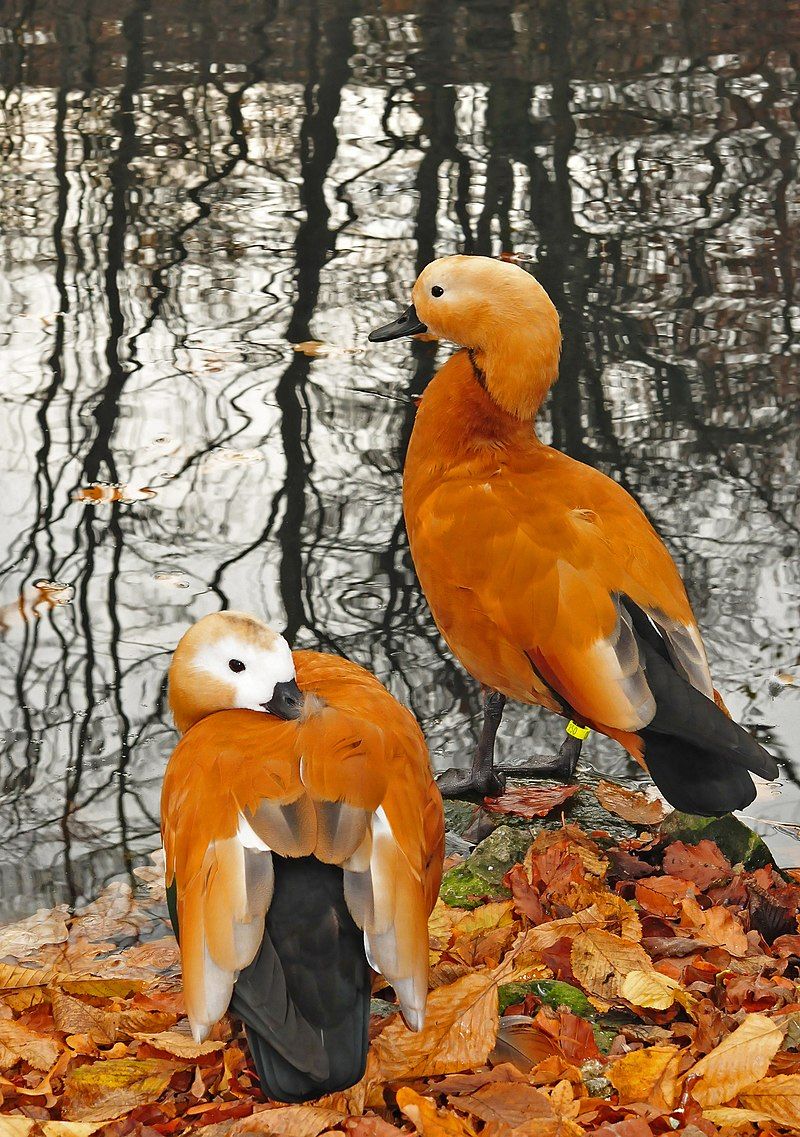
The ruddy shelduck, also known as the Brahminy duck, is a distinctive species of waterfowl that belongs to the family Anatidae. It is easily recognizable due to its distinct size and features, measuring between 58 and 70 cm in length and having a wingspan of 110 to 135 cm.
This duck species is mainly found in India but can also be seen in other parts of Asia, the Middle East, and Europe. The ruddy shelduck has a unique plumage, varying depending on the location and season.
Generally, their feathers are reddish-brown on the head, neck, and breast, while the back and wings are darker. The bill is usually olive green, with white patches on the wings and tail. Additionally, their legs and feet are typically orange or yellow.
In the wild, these ducks typically inhabit wetlands, lakes, marshes, and other areas with shallow water. They feed on a variety of aquatic plants, seeds, and insects. During the breeding season, the male ruddy shelduck will perform a courtship dance to attract a mate.
The female will then lay between 5 and 12 eggs in a nest in a tree cavity or on the ground. The ruddy shelduck is an essential species in its native habitat, playing a vital role in the environment.
Unfortunately, their numbers have declined due to human activities such as hunting, habitat destruction, and pollution. Currently, the IUCN Red List of Threatened Species lists the species as near threatened.
| Kingdom | Animalia |
| Phylum | Chordata |
| Class | Aves |
| Order | Anseriformes |
| Family | Anatidae |
| Genus | Tadorna |
| Species | T. ferruginea |
4. Great Crested Grebe
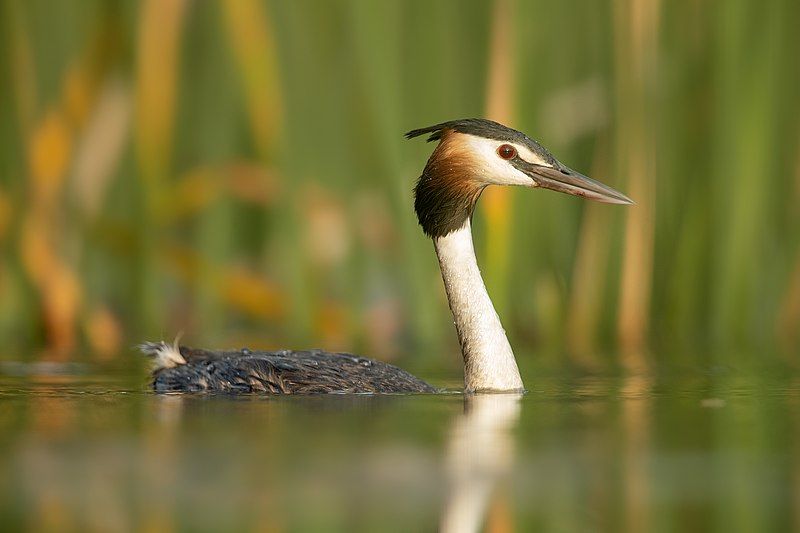
The great crested grebe, which belongs to the grebe family of water birds, is a species of bird known for its elaborate courtship display. The males often perform a display known as “penguin-dancing,” in which they perform a series of leaps and dives around their partner.
They also engage in “head-shaking,” which involves shaking their head and body back and forth in a dance-like fashion.
Both of these behaviors are used to attract potential partners and to strengthen the bond between two mates. The great crested grebe is also known for its colorful breeding plumage, which includes a white neck and breast, black sides and back, and a distinctive red-brown cap.
They can be found in shallow lakes, ponds, and marshes during the breeding season.
These birds are primarily solitary but will form small colonies during the breeding season. The great crested grebe has a distinct diet, which includes fish, amphibians, mollusks, crustaceans, and aquatic insects. They use their long, pointed bill to catch their prey.
They also use their feet to help them swim and search for food underwater. The great crested grebe is a stunning bird, and its elaborate mating display is certainly something to behold.
Its colorful plumage, unique courtship behaviors, and ability to thrive in aquatic habitats make it an essential part of the global ecosystem.
| Kingdom | Animalia |
| Phylum | Chordata |
| Class | Aves |
| Order | Podicipediformes |
| Family | Podicipedidae |
| Genus | Podiceps |
| Species | P. cristatus |
5. Little Grebe
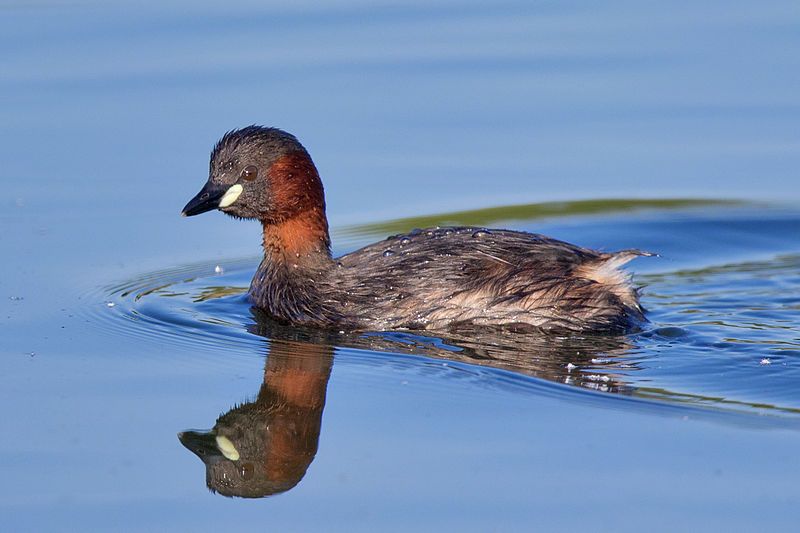
The little grebe, also known as dabchick, is a species of water bird belonging to the family of grebes. Its scientific name is from Ancient Greek, with the genus name “thus,” meaning “fast,” and “bapto,” meaning “to sink under.”
The specific name “ruficollis” is derived from Latin, with “Rufus” meaning “red” and “Collis” meaning “necked,” which itself has been taken from the Latin word “collum,” which means “neck.”
The little grebe is a small body water bird usually found in shallow lakes, ponds, and other wetlands. It has an olive-brown body with a white patch around its neck, giving it its “red-necked” nickname.
Its legs are short, and its sharp claws allow it to move quickly across the water and even dive underwater. The little grebe feeds by diving underwater and eating small fish, invertebrates, and aquatic plants.
They also build their nests on floating vegetation in shallow water.
| Kingdom | Animalia |
| Phylum | Chordata |
| Class | Aves |
| Order | Podicipediformes |
| Family | Podicipedidae |
| Genus | Tachybaptus |
| Species | T. ruficollis |
6. Red-breasted Goose
The red-breasted goose is a species in Eurasia and part of the genus Branta. This species is easily recognizable due to its bright markings.
Unfortunately, the red-breasted goose is currently classified as vulnerable by the International Union for Conservation of Nature (IUCN). This means the species risk becoming endangered or extinct due to various factors, such as habitat destruction or hunting.
The IUCN encourages conservation efforts to help ensure the survival of this species. Conservation efforts should focus on protecting the red-breasted goose’s natural habitat.
Reducing human activity and pollution in their breeding and nesting grounds can help maintain the species’ population.
Additionally, hunting regulations and restrictions should be enforced to protect the goose from being hunted to extinction.
The red-breasted goose is an integral part of the ecosystem and needs to be protected from the threats it faces. It is our responsibility to ensure its survival through conservation and protection.
By taking action now, we can ensure the long-term survival of the red-breasted goose and other species like it.
| Kingdom | Animalia |
| Phylum | Chordata |
| Class | Aves |
| Order | Anseriformes |
| Family | Anatidae |
| Genus | Branta |
| Species | B. ruficollis |
7. Great Bustard
The great bustard is a large bird belonging to the bustard family, a group of birds found in parts of Europe, Africa, and Asia. It is the only living species in its genus, Otis.
The great bustard can be found in open grasslands and farmland in various locations, from northern Morocco in Africa to parts of Central and South Europe and East and Central Asia.
It is considered an endangered species due to the loss of its natural habitats due to human activities. Its habitats are being conserved and protected in some areas to protect the species.
Breeding programs are also being implemented to help increase the population of the great bustard.
| Kingdom | Animalia |
| Phylum | Chordata |
| Class | Aves |
| Order | Otidiformes |
| Family | Otididae |
| Genus | Otis |
| Species | O. tarda |
8. Eurasian Coot

The Eurasian coot is a rail and crake bird family member, Rallidae. It is widely distributed across Europe, Asia, Australia, New Zealand, and North Africa.
This bird has a unique appearance: a slaty-black body, a glossy black head, and a white bill with a white frontal shield.
This white bill is a distinguishing feature, as it is particularly noticeable. The Eurasian coot is an omnivorous bird, primarily feeding on aquatic vegetation, crustaceans, mollusks, insects, and seeds.
It also feeds on small fish, amphibians, and even some small mammals. It is a social bird, usually found in flocks and foraging in shallow waters.
During the breeding season, the Eurasian coot builds a nest close to the water, usually on an island or in flooded vegetation.
The nest is constructed of vegetation and lined with feathers or down. The Eurasian coot is a vocal bird with various calls and whistles used to communicate and defend its territory.
It is also known to perform a variety of courtship displays, including head-bobbing, wing-flicking, and bill-dipping. Overall, the Eurasian coot is a widespread and fascinating bird with a unique appearance and behavior.
It is an integral part of the ecosystems it inhabits, helping to maintain a balance between aquatic vegetation and predators.
| Kingdom | Animalia |
| Phylum | Chordata |
| Class | Aves |
| Order | Gruiformes |
| Family | Rallidae |
| Genus | Fulica |
| Species | F. atra |
9. Black-winged Stilt
The black-winged stilt is a well-known, long-legged wading bird from the avocet and stilt family. It is widely distributed across many continents and has the scientific name of H. himantopus.
This species is usually considered a single, almost cosmopolitan species, which means it can be found on different continents and in various environments. The black-winged stilt is an exciting species due to its unique appearance and behavior.
It has long, thin legs that are bright red. The feathers of the black-winged stilt are also black, and the head and neck are white. Its beak is yellow and black, and its eyes are dark.
The black-winged stilt is a wader, meaning it spends much of its time searching for food in shallow water. The black-winged stilt is often seen in wetlands, lakes, rivers, and coasts.
It breeds in shallow, temporary wetlands and can be found in many parts of Europe, Asia, Africa, and Oceania.
The black-winged stilt is integral to many ecosystems, as it feeds on small invertebrates, such as insects and crustaceans. Overall, the black-winged stilt is a fascinating species that is widely distributed and is identified by its scientific name, H. himantopus.
It is a unique species with its long legs and black and white feathers and is an integral part of many ecosystems.
| Kingdom | Animalia |
| Phylum | Chordata |
| Class | Aves |
| Order | Charadriiformes |
| Family | Recurvirostridae |
| Genus | Himantopus |
| Species | H. himantopus |
10. Red-crested Pochard
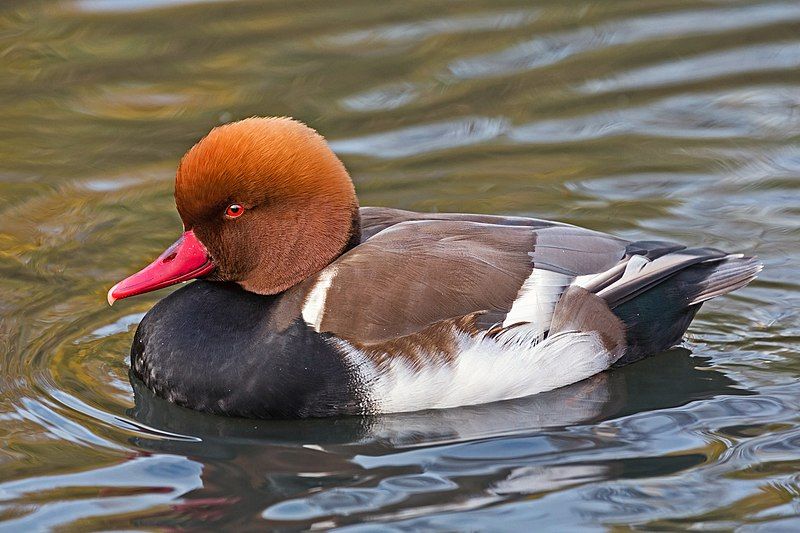
The red-crested pochard is a large diving duck found in various parts of the world. It is known for its distinguishing red crest visible on the duck’s head. This bird is also distinguished by its scientific name, derived from Greek and Latin.
The Greek word Netta, which translates to “duck”, is combined with the Latin word Rufina, which means “golden-red”, to create the scientific name of the red-crested pochard.
This name accurately reflects the appearance of the duck, which its red crest and golden-red coloring can identify. The red-crested pochard is a waterfowl species that can dive to reach its food.
This diving duck has a long bill and webbed feet, which help it to travel through the water quickly. The red-crested pochard is a migratory species that flies long distances to reach its wintering grounds.
This species is a favorite among birdwatchers, as it is relatively easy to identify due to its unique and recognizable markings. Overall, the red-crested pochard is a species of diving duck easily recognized by its red crest and golden-red coloring.
Its scientific name is derived from the Greek Netta, which means “duck,” and the Latin Rufina, which means “golden-red.” This duck species is known for its ability to dive and migrate over long distances, making it an exciting species for birdwatchers to observe.
| Kingdom | Animalia |
| Phylum | Chordata |
| Class | Aves |
| Order | Anseriformes |
| Family | Anatidae |
| Genus | Netta |
| Species | N. rufina |
Conclusion
Birds play an essential role in Atyrau, providing food, entertainment, and a sense of connection to nature. They are also seen as a symbol of joy, freedom, and good luck.
As such, protecting and preserving these birds in Atyrau is essential to maintain the region’s biodiversity and sustain its natural beauty.